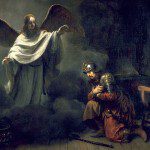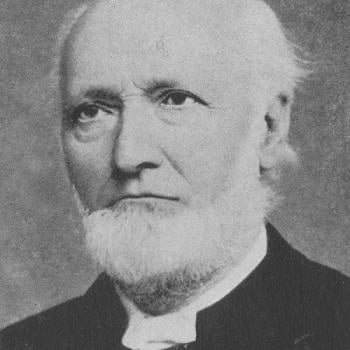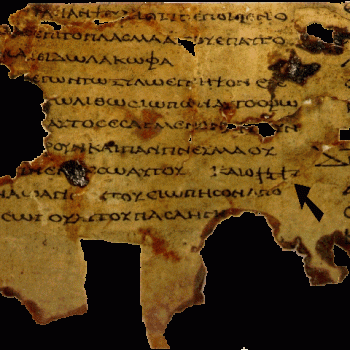Mitch / “ProfMTH”‘s Video Jesus Was Not the Messiah – Pt. I

Straw men, on the Tour de France cycling route, in Lautrec. Photograph by Robin Ellis (8-23-10) [Flickr / CC BY-ND 2.0 license]
(7-1-10)
*****
[Mitch was made aware of my three critiques of his material. He never replied]
***
I was made aware (by an atheist friend) of a ten-minute You Tube video by one Mitch / “ProfMTH”: an atheist who loves to try to shoot down the Bible: in 270 videos so far.
Mitch / “ProfMTH” is about 46 years old and is a former Catholic. In his video, The Book of Job – Part One (at 0:57 – 1:03), Mitch says he was getting ready to graduate from high school in 1981 and at the same time “was considering entering religious life, to study for the priesthood.” In a comment under his August 2009 video, The “Real” Paul, Mitch states, “I teach various law courses and courses on debate.”
I’d like to reply in some depth to several of the arguments presented in his video, Jesus Was Not the Messiah – Part One (5-31-09)
First of all, Glenn Miller at the excellent website, Christian Think Tank, provides several quotations from Christian commentaries that give a perfectly plausible explanation for the Jeremiah-Zechariah citation from Matthew regarding the thirty pieces of silver and the potter’s field, that was brought up as an alleged insuperable difficulty.
Secondly, I find it curious and a bit humorous that the skeptic here chides Matthew for supposed partial citation and/or botched citation, when in fact he does the same exact thing. He cites the notes for the New American Bible (NAB) for Matthew 27:9-10, saying that a particular text cited there is not in Jeremiah, while not informing his followers of what the footnote goes on to say:
It is usually said that the attribution of the text to Jeremiah is due to Matthew’s combining the Zechariah text with texts from Jeremiah that speak of a potter (18, 2-3), the buying of a field (32, 6-9), or the breaking of a potter’s flask at Topheth in the valley of Ben-Hinnom with the prediction that it will become a burial place (19, 1-13).
Thirdly, it is asserted that Psalm 69 cannot be messianic because 69:5 asserts sin on the part of the speaker. But this betrays an ignorance (again) of how Hebrew typology works. King David was a prototype of the Messiah in important respects (a king, a leader of His people, zealous for God, etc.). It’s simply not required for the prototype of something to possess absolutely every attribute of the type it foreshadows. That is the fundamental fallacy of this reasoning.
David is portrayed in the Bible (as are virtually all major figures) as a sinner; most notably in the most unsavory adultery-murder incident with Bathsheba (and see his repentance in Psalm 51). It doesn’t follow that he cannot be a prototype or a typological figure for the Messiah because he committed these sins.
Hence, the Bible (in the prophetic books) freely presents David as such, and the Messiah is even called “David” in several instances (meaning that he will be like him in important — but not all — respects):
Jeremiah 23:5 (RSV) Behold, the days are coming, says the LORD, when I will raise up for David a righteous Branch, and he shall reign as king and deal wisely, and shall execute justice and righteousness in the land. (cf. 33:15, 17; Is 11:1-10)
Jeremiah 30:9 But they shall serve the LORD their God and David their king, whom I will raise up for them.
Ezekiel 34:23-24 And I will set up over them one shepherd, my servant David, and he shall feed them: he shall feed them and be their shepherd. [24] And I, the LORD, will be their God, and my servant David shall be prince among them; I, the LORD, have spoken.
Ezekiel 37:24-25 My servant David shall be king over them; and they shall all have one shepherd. They shall follow my ordinances and be careful to observe my statutes. [25] They shall dwell in the land where your fathers dwelt that I gave to my servant Jacob; they and their children and their children’s children shall dwell there for ever; and David my servant shall be their prince for ever.
Hosea 3:5 Afterward the children of Israel shall return and seek the LORD their God, and David their king; and they shall come in fear to the LORD and to his goodness in the latter days. (cf. Amos 9:11)
Zechariah 12:8 On that day the LORD will put a shield about the inhabitants of Jerusalem so that the feeblest among them on that day shall be like David, and the house of David shall be like God, like the angel of the LORD, at their head.
A similar dynamic is seen in the New Testament when John the Baptist is compared to Elijah: almost (but not absolutely literally) equated with him (because this is how Hebrew typology works): Matthew 11:14; 17:10-12; Mk 9:11-13.
The literal sense of what this is showing is seen in, e.g., Luke 1:17: “. . . he will go before him in the spirit and power of Eli’jah . . .”
But John the Baptist was not exactly like Elijah (or vice versa) because typologies and analogies don’t require that in the first place. Thus, we see the Bible portraying Elijah’s lack of faith, or a sort of despair or self-pity even after his great encounter with the false prophets on Mt. Carmel (1 Kings 19:4, 10-11, 14). We see no such lack of resolve in John the Baptist, who indeed was said to be “filled with the Holy Spirit, even from his mother’s womb” (Luke 1:15). So it is another clear example of the type and fulfillment of an earlier prototype not being exactly the same in all respects.
Therefore, the argument against Psalm 69 being messianic on the grounds that it mentions the sins of David, collapses.
For more on biblical typology, see “The Typological Interpretation of Scripture,” by Keith Poysti. Here is an excerpt that is harmonious with my reasoning above:
Many scholars have noticed that typological interpretation goes back further than Jesus. Goppelt, von Rad, Daniélou, and Eichrodt among others, have seen a typological approach to past events already at work in the Old Testament writings. These scholars argue that typology is rooted in the prophets. Goppelt’s summary is typical: the prophets foresaw a new exodus (Hos. 2:17; Jer. 16:14f; Isa. 43:16-21; 48:20f.), a new covenant (Jer. 31:31-34; Isa. 54:9f.), a second kingdom of David (Amos 9:11f; Isa. 11:1-10; Mic. 5:1; Ezek. 34:23f), a new Zion (Isa. 2:2ff; Isa. 54:11-14), and a new creation like paradise (Isa. 11:6ff; 51:3). It is no wonder that the prophets grounded their appeals and promises in the events of the past. In so doing, they drew on God’s unchanging character; what God did in the past was a pattern of or a basis for what would happen in the future.
Fourth, Mitch makes a big fuss about Matthew 1:23 (“his name shall be called Emmanuel” — RSV), claiming that Matthew deliberately changed the quotation in a nefarious, dishonest fashion. Here is the Isaiah 7:14 passage that is cited:
Therefore the Lord himself will give you a sign. Behold, a young woman shall conceive and bear a son, and shall call his name Imman’u-el.
He insinuates that the sense was changed from the mother naming the child, to a general scenario of others calling him the name, in order to avoid contradiction (far as I can tell, from his convoluted argument) with Matthew 1:21 (“you shall call his name Jesus”). He notes that the NT (i.e., in some translations, not all) uses the terminology of “they shall call . . .”). Of course, the Bible is filled with examples of people (including God) being referred to by multiple names, so that in and of itself is a non sequitur with regard to proposed biblical “contradictions.”
But this argument leads into another huge subject area: the nature and parameters of ancient Hebrew citation. Was it exactly the same as our practice today (no)? Was there a latitude in terms of minute accuracy and word-for-word repetition (yes)? Mitch casually presupposes that ancient citation practices would be exactly the same as ours today. But this is simply not the case.
In order to provide an introductory treatment for the benefit of the skeptic and my readers, I found an excellent article, “New Testament Use of the Old Testament,” by Roger Nicole, from Revelation and the Bible, edited by Carl. F. H. Henry (Grand Rapids: Baker, 1958), pp. 137-151. The principles elucidated here are applicable to many of the misguided criticisms made in this video. Here is just one section:
3. The New Testament writers sometimes paraphrased their quotations.
a. Under this heading we might first mention certain cases where we find a free translation of the Hebrew rather than a real paraphrase. Such a procedure certainly needs no justification, since a free translation sometimes renders the sense and impression of the original better than a more literal one.
b. Slight modifications, such as a change of pronouns, a substitution of a noun for a pronoun or vice versa, transformations in the person, the tense, the mood or the voice of verbs, are sometimes introduced in order to better suit the connection in the New Testament. These paraphrases are perhaps the most obviously legitimate of all.
c. There are cases in which the New Testament writers obviously forsake the actual tenor of the Old Testament passage in order to manifest more clearly in what sense they were construing it. In this they are quite in agreement with the best modern usage, as represented, for example, in W.G. Campbell, A Form Book for Thesis Writing (New York, Houghton Mifflin 1939): “A careful paraphrase that does complete justice to the source is preferable to a long quotation” (p. 15).
d. In certain cases the New Testament writers do not refer to a single passage, but rather summarize the general teaching of the canonical books on certain subjects in phrasing appropriate to the New Testament, although as to the essential thought they express indebtedness to, or agreement with, the Old Testament. This method of referring to the Old Testament teachings is obviously legitimate. The following passages might be viewed as examples of “quotations of substance,” as Franklin Johnson calls them in his able treatise on The Quotations of the New Testament from the Old Considered in the Light of General Literature (London, Baptist Tract and Book Society, 1896):
Matthew 2:23; 5:31, 33; 12:3, 5; 19:7; 22:24; 24:15; 26:24, 54, 56; Mark 2:25; 9:12, 13;10:4; 12:19; 14:21, 49; Luke 2:22; 6:3; 11:49; 18:31; 20:28; 21:22; 24:27, 32, 44-46; John 1:45; 5:39, 46; 7:38, 42; 8:17; 17:12; 19:7, 28; 20:9; Acts 1:16; 3:18; 7:51; 13:22, 29; 17:2, 3; Romans 3:10; 1 Corinthians 2:9; 14:34; 15:3, 4, 25-27; 2 Corinthians 4:6; Galatians 3:22; 4:22; Ephesians 5:14; James 4:5; 2 Peter 3:12, 13.
e. Finally, we must consider the possibility that the writers of the New Testament, writing or speaking for people well acquainted with the Old, may in certain cases have intended simply to refer their readers or hearers to a well-known passage of Scripture. Then, in order to suggest it to their memory they may have accurately cited therefrom some expressions, which they then placed in a general frame different from that of the original. At times the actual words quoted may have been intended merely or primarily to indicate the location of a passage, as the general context of the Old Testament in which the stipulated truth could be found, rather than as an express citation.
The author notes a host of other considerations having to do with the method and content of citation that are also in play. Suffice it for my purpose to say that it is clearly a case of a matter being far more complex than it is made out to be by the critic.
Fifth; in another of his arguments, Mitch claims that Matthew 1:23 makes a citation to the Old Testament that is simply not present there. Here it is:
And he went and dwelt in a city called Nazareth, that what was spoken by the prophets might be fulfilled, “He shall be called a Nazarene.”
He is at least accurate in a statement of fact (credit where it is due). The text is indeed not in the Old Testament. But he is wrong in his underlying assumption and in the conclusion he draws from it. He assumes that the author must be referring to the Old Testament. This is incorrect in the first place, since the text doesn’t say that, and merely refers to “the prophets.” Secondly, he concludes that since it isn’t there, it is therefore dishonest. This is what happens when one jumps to the conclusion based on an inaccurate premise (itself due to a lack of proper knowledge).
It is well-known that the Jews of that time (particularly the mainstream Pharisaical party that Jesus and Paul — see, e.g., Acts 23:6; 26:5; Phil. 3:5 — both considered themselves part of) accepted oral tradition as well as the written, scriptural tradition. Much of the oral tradition was later written down, in the Talmud and other Jewish rabbinical works.
This particular text refers to words “spoken by the prophets.” That could very well be a reference to an oral tradition, particularly in light of the fact that there are several allusions in the New Testament that (quite consciously) do not have (or intend to have) a reference in the Old Testament. Catholics in particular have noted this for years. In fact, oral tradition remains a strong motif and source of authority in the New Testament, as I have noted, with a compilation of many scores of passages. Matthew 2:23 is just one example. There are several other well-known ones:
Matthew 7:12 So whatever you wish that men would do to you, do so to them; for this is the law and the prophets. (cf. Lk 6:31; 10:25-28)
The “golden rule” cannot be found as such in the Old Testament, though the concept is surely present (it can be straightforwardly deduced from Leviticus 19:,18, 34). It is also present in the deuterocanonical book Tobit (rejected by Protestants as Scripture: 4:15a: “And what you hate, do not do to any one . . .”). Something very similar was stated by the rabbi Hillel, among others:
That which is hateful to you, do not do to your fellow. That is the whole Torah; the rest is the explanation; go and learn.
(Talmud, Shabbat 31a)
Note that “the prophets” are alluded to, as in Matthew 1:23. The “prophets” were not considered to be confined solely to the Old Testament.
Matthew 23:2 The scribes and the Pharisees sit on Moses’ seat;
The phrase or idea of Moses’ seat cannot be found anywhere in the Old Testament. It is found in the (originally oral) Mishna, where a sort of “teaching succession” from Moses on down is taught.
1 Corinthians 10:4 and all drank the same supernatural drink. For they drank from the supernatural Rock which followed them, and the Rock was Christ.
The Old Testament says nothing about such miraculous movement, in the related passages about Moses striking the rock to produce water (Exodus 17:1-7; Numbers 20:2-13). But rabbinic tradition does.
2 Timothy 3:8 As Jannes and Jambres opposed Moses, so these men also oppose the truth, men of corrupt mind and counterfeit faith;
These two men cannot be found in the related Old Testament passage (Exodus 7:8 ff.), or anywhere else in the Old Testament. But they are found in various extra-biblical works. The so-called Zadokite Work in the Qumran literature refers to Belial enlisting “Yohaneh and his brother” against Moses and Aaron. The Babylonian Talmud refers to “Yohane and Mamre” (Menahoth 85a). The names were in common use in Jewish legend, and even pagan writers like Pliny referred to one or both of them.
1 Peter 3:19 in which he went and preached to the spirits in prison,
This is drawn from the Jewish apocalyptic book 1 Enoch (12-16).
Jude 14-15 It was of these also that Enoch in the seventh generation from Adam prophesied, saying, “Behold, the Lord came with his holy myriads, to execute judgment on all, and to convict all the ungodly of all their deeds of ungodliness which they have committed in such an ungodly way, and of all the harsh things which ungodly sinners have spoken against him.”
Here is an instance of “prophesying”: it is a direct quotation of 1 Enoch 1:9: a book that is not part of the Old Testament (last time I checked).
From all of this evidence one rationally concludes that the New Testament writers acknowledged spiritual and theological authority in sources beyond the Old Testament. None of the additional examples above claim to cite the Old Testament (precisely as is also the case with Matthew 1:23). But Mitch casually assumes without warrant that they are doing so.
He wishes to critique the allegedly shoddy and dishonest practices of the New Testament writers, and in so doing tear down Christianity (or at least biblical inspiration and the claims of Jesus as Messiah and Lord and God)? Jesus Himself had some wise advice for people who act like this:
Luke 6:41-42 Why do you see the speck that is in your brother’s eye, but do not notice the log that is in your own eye? [42] Or how can you say to your brother, ‘Brother, let me take out the speck that is in your eye,’ when you yourself do not see the log that is in your own eye? You hypocrite, first take the log out of your own eye, and then you will see clearly to take out the speck that is in your brother’s eye.













